Henry Husbands, ca. 1824 – 1900
and
William Clarke, ca. 1810 – 1873
Husbands and Clarke,
Husbands,
and
Husbands and Sons
by Brian Stevenson
last updated November, 2023
Henry
Husbands and William Clarke operated an optician and scientific instruments shop in Bristol, England, as partners between 1858 and 1870, then Husbands alone or with his sons until that man’s death in 1900. Three of Henry’s sons maintained the Husbands and Sons’ shop for 10 additional years. Two other of Henry’s sons opened branches in Melbourne, Australia, in 1875. Alison Morrison-Low wrote that Husbands and Clarke / Husbands “appear to have been the main suppliers of instruments locally (i.e. Bristol) in the latter part of the nineteenth century,” and that many of their instruments have survived to this day. In contrast, microscope slides from the firm are relatively uncommon.
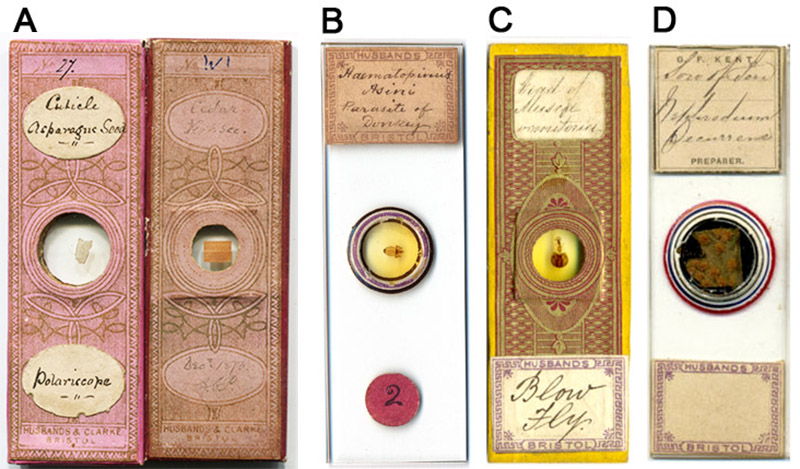
Figure 1. Microscope slides retailed by Husbands and
Clarke (A) and by Husbands (B, C, and D).
A. Two paper-wrapped “Husbands and Clarke” slides. The slide on the right has a date of December, 1873 written in pencil.
B. A later, unpapered slide. Brian Bracegirdle’s
‘Microscopical Mounts and Mounters’ Plate 21-R illustrates a similarly labeled slide, with the same handwriting on the label. Presumably, these slides were brought in from outside professional/semi-professional slide makers, or produced by junior employees, since skilled opticians such as Husbands and Clarke could more profitably spend their time producing lenses and other
high-skill apparatus.
C. A slide made by London-based mounter John Norman, with a retail label from Husbands.
D. A slide produced by G.F. Kent, with a retail label from Husbands.

Figure 2. An uncut sheet of Husbands and Clarke microscope slide-cover papers. Even after 140+ years, such items occasionally pop up in auctions.
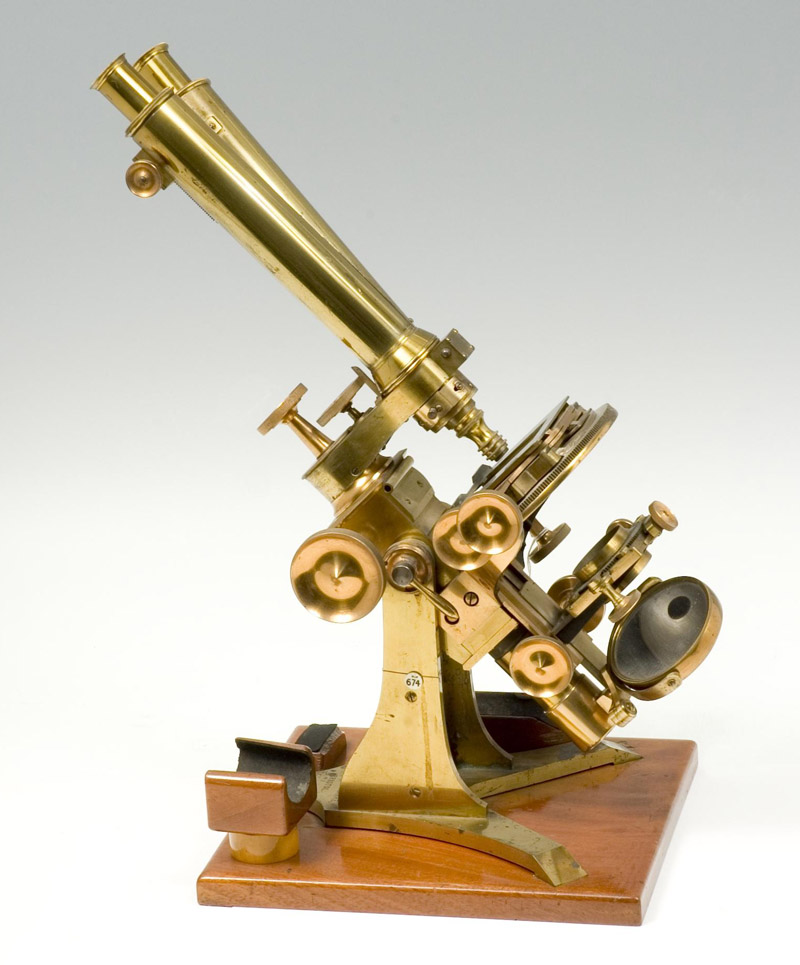
Figure 3A. A microscope engraved “Husbands and Clarke Bristol”. Image from the Museum of the History of Science.
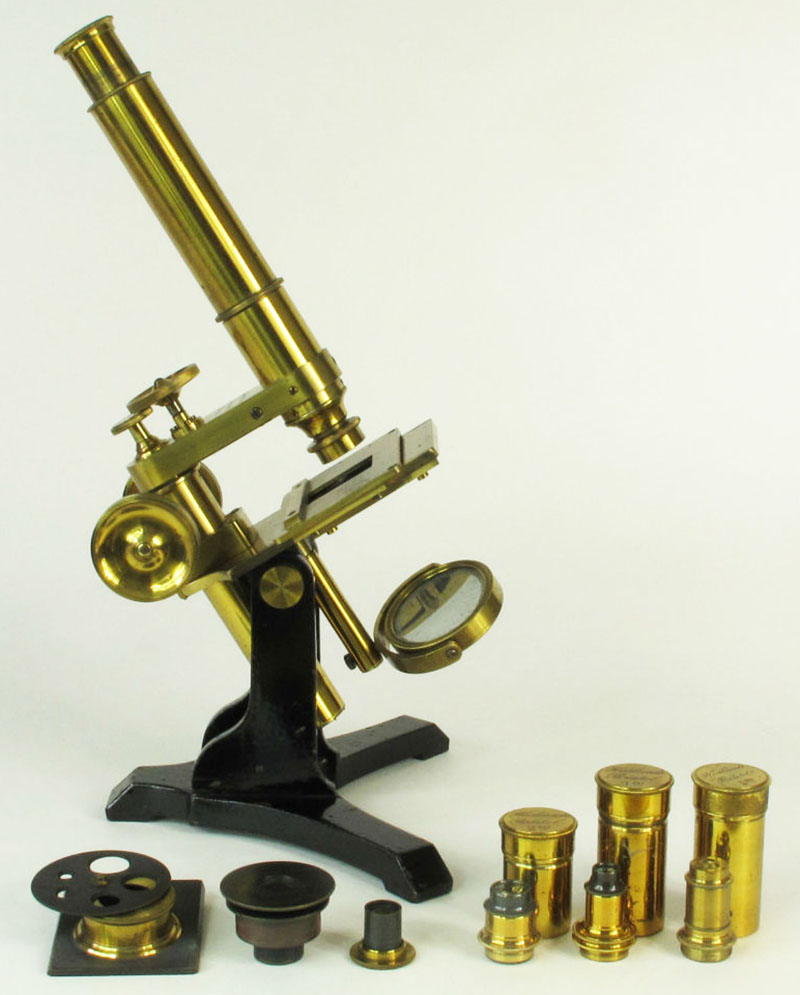
Figure 3B. Another Husbands and Clarke microscope, probably dating from after that shown in Figure 3A. Image adapted for nonprofit, educational purposes from an internet auction site.
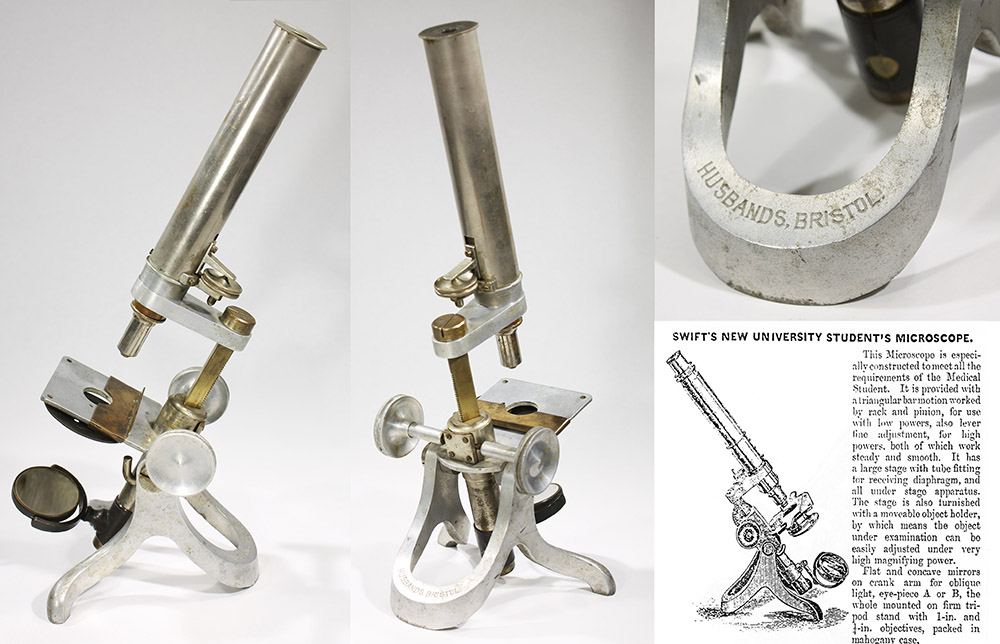
Figure 4. The foot is engraved "Husbands, Bristol", although this microscope was very likely manufactured by Swift & Son, London - it is essentially identical to Swift's ca. 1870s-1880s "New University Student's" model (excerpt from Swift's 1874 catalogue is shown). This example is particularly noteworthy because the foot, focus knobs, arm, and other components are made of cast aluminum, with the body tube and lens mounts made of nickel-plated brass.
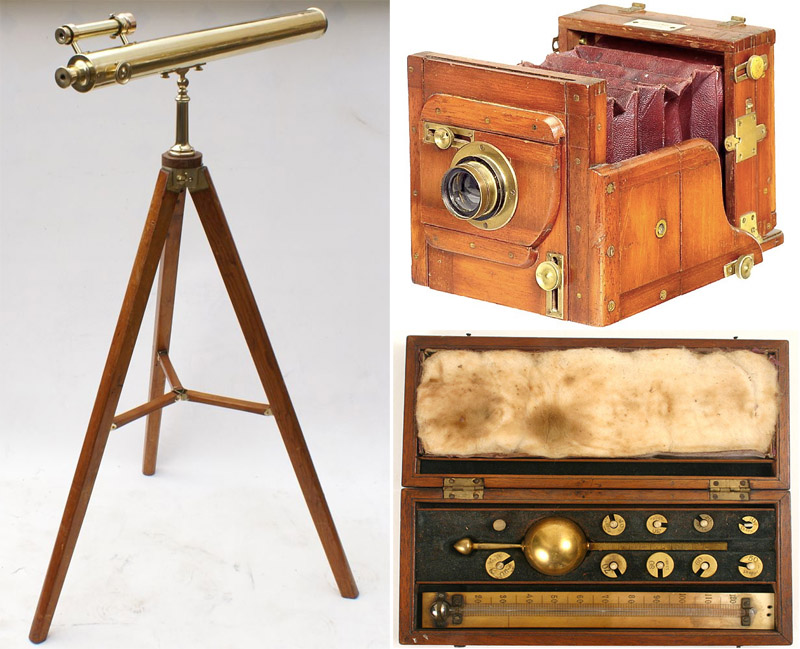
Figure 5. Other scientific instruments produced by Husbands and Clarke or Husbands alone: a reflecting telescope and tripod engraved “Husbands Bristol”, a wood-frame camera labeled “Husbands Bristol” and a cased Sikes hydrometer labeled “Husbands and Clarke Bristol”. Screenshot
images from internet auctions.

Figure 6. Three smaller products: ivory set-square and
parallel rule engraved “Husbands and Clarke Bristol”, folding tortoiseshell
eyeglasses and case labeled “Husbands Bristol”, and a parallel rule engraved
“Husbands Bristol”. Screenshot images from internet auctions.
Both Husbands and Clarke initially worked as senior journeymen for Thomas Davies King (1819-1884), a Bristol optican and manufacturer of microscopes and other scientific and engineering apparatus. King operated shops at 2 Clare Street (which was also his family’s home), and a second on the corner
of Denmark Street and St. Augustine’s Parade, numbered both 1 Denmark Street and
8 St. Augustine’s Parade (see Figure 8).
Henry Husbands was born in the St. Augustine parish of Bristol. Census records suggest a birth date of 1824. His parents appear to have died early on, as the 1841 census recorded that the Husbands’ household consisted of only ca. 20 year old James (engineer), ca. 15 year old Ellen Husbands (dress maker), ca. 15 year old Henry (optician apprentice) and ca. 15 year old William (woolen draper) (the 1841 census rounded off ages). In 1846, Henry married Emma Hooper, also of Bristol. The couple had 8 children, 6 sons and 2 daughters.
William Clarke was born in Tiverton, Devonshire, circa 1810. He may have been the boy of that name christened in Tiverton on January 21, 1810, son of William and Agnes Clark(e). The 1841 and 1851 censuses located Clarke in Bristol, employed as a “cabinet maker”. If Clarke was then working for the Kings, his job description suggests that he made the wooden components of their instruments. Clarke and his wife, Matilda, had 6 children, 2 sons and 4 daughters.
Around 1856-1858, Husbands and Clarke took over T.D. King’s Denmark Street business, although the date is obscure. Most references cite 1858, the same year that King emigrated to Canada, although King had filed for bankruptcy in 1856. The Clare Street shop was continued by King's son-in-law, James Blake Gardiner.
Beginning on April 24, 1858, several months of advertisements from Husbands and Clarke appeared weekly in the Bristol Mercury, likely marking the business' opening. Those
advertisements were for Field and Son’s “Society of Arts Prize” microscopes, and remarked that Husband and Clarke were Field’s “sole agents”. That may have been to provide income to the new partnership while they constructed items of their own for sale.
By August, 1860, the partners were doing well enough to donate one of their barometers to the Bristol Royal Infirmary. This was excellent advertising for the new firm, with an announcement of the gift in the Medical Times and Gazette stating that “It has been placed in the entrance hall of the Infirmary, and is much admired”.
Husbands and Clarke exhibited some of their productions at the 1862 International Exposition in London. Entry 3003 was their “optical instruments”, and entry 3009 was a “traversing
theodolite and portable equatorial”. Coincidentally, the London Microscopical Society exhibited Peters’ machine for microscopic writing next to Husbands and Clarkes’ optical instruments, in booth 3004.
An idea of the diversity of Husbands and Clarkes’ productions is provided by the following account of the 1867 Clifton Industrial Exhibition, “Messrs. Husbands and Clarke contributed a valuable collection of microscopes and other scientific instruments, together with some galvanic batteries, and a miniature locomotive worked by electricity, an ingenious and interesting piece of mechanism”.
Husbands and Clarke dissolved their partnership on October 4, 1870, with Husbands taking over the debts. William Clarke died February 25, 1873. That raises the possibility that failing health may have forced Clarke’s retirement.
Writing on “the microscope in pharmacy” in 1872, Henry Pocklington gave high praise to Husbands’ microscopes, “an instrument, with the addition of a
polariscope and fittings, will suffice for the ordinary work of either the pharmacist or the medical man, and may be purchased for £7 of any of half-a-dozen good makers in town and country. There are so many makers whose instruments answer the requirements of students, and are sold within the limits
we have given, that we hesitate to particularize any; but in common justice I am bound to say that I have received from Messrs. Swift, of London, and Winspear, of Hull, the utmost courtesy and assistance in my many microscopical emergencies. The latter maker has especially been always ready to carry into effect any economical ‘dodge’ to which fancy or the force of circumstances may have impelled me, and his ‘Student’ strikes me as being so pre-eminently a student's instrument, that it affords me much pleasure to mention it in this place. I have seen and used the Student's or other cheap instruments of Messrs. Beck, Wheeler, Collins and others, of London; Dancer, of Manchester; and Husbands, of Bristol; and have no hesitation in recommending my readers to their very ‘tender mercies’, in common with the not less worthy brethren for whose names I have no space”.
In 1875, two of Henry Husband’s sons, William Samuel and Charles Frederick, emigrated to
Melbourne, Australia. William bought the optical manufacturing and importing business of John Grimoldi at 81 Queen Street. Charles business was at 454 Bourke Street. Records of the Powerhouse Museum (Sydney) indicate that Henry and his sons engaged in legal disputes over the ownership of the Bourke Street shop. An 1889 advertisement implies that William ultimately acquired ownership
(Figure 9).
Henry Husbands traveled to Australia in 1881 for the Melbourne International Exhibition, where he won a Gold Medal for his improved version of the Metford theodolite, developed by William Ellis Metford (1824-1899). He again traveled to Australia in 1883-84, to settle business matters with his
sons.
In 1883, Husbands advertised that he was distributor for Edmund Hartnack’s microscopes and lenses (Figure 10). Other ads from that period indicated that he supplied instruments from London makers (Figure 11).
The business became “Husbands and Sons” in 1893. Henry Husbands died in 1900. His sons Henry James, James Wessen and Alfred Witchell Husbands continued the business until 1910, formally dissolving the partnership on March 1 of that year.
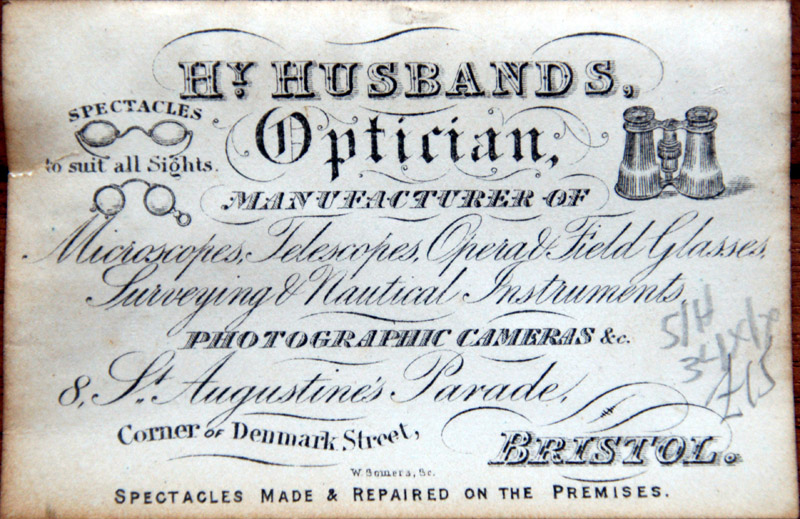
Figure 7. Trade card from Henry Husbands, from 1870. This is attached to the case of a telescope that had been repaired by Husbands. The pencil writing implies that the work cost £15 and was performed on October 3, 1870. That was when Husbands and Clarke dissolved their partnership. Courtesy of Chris Lord.
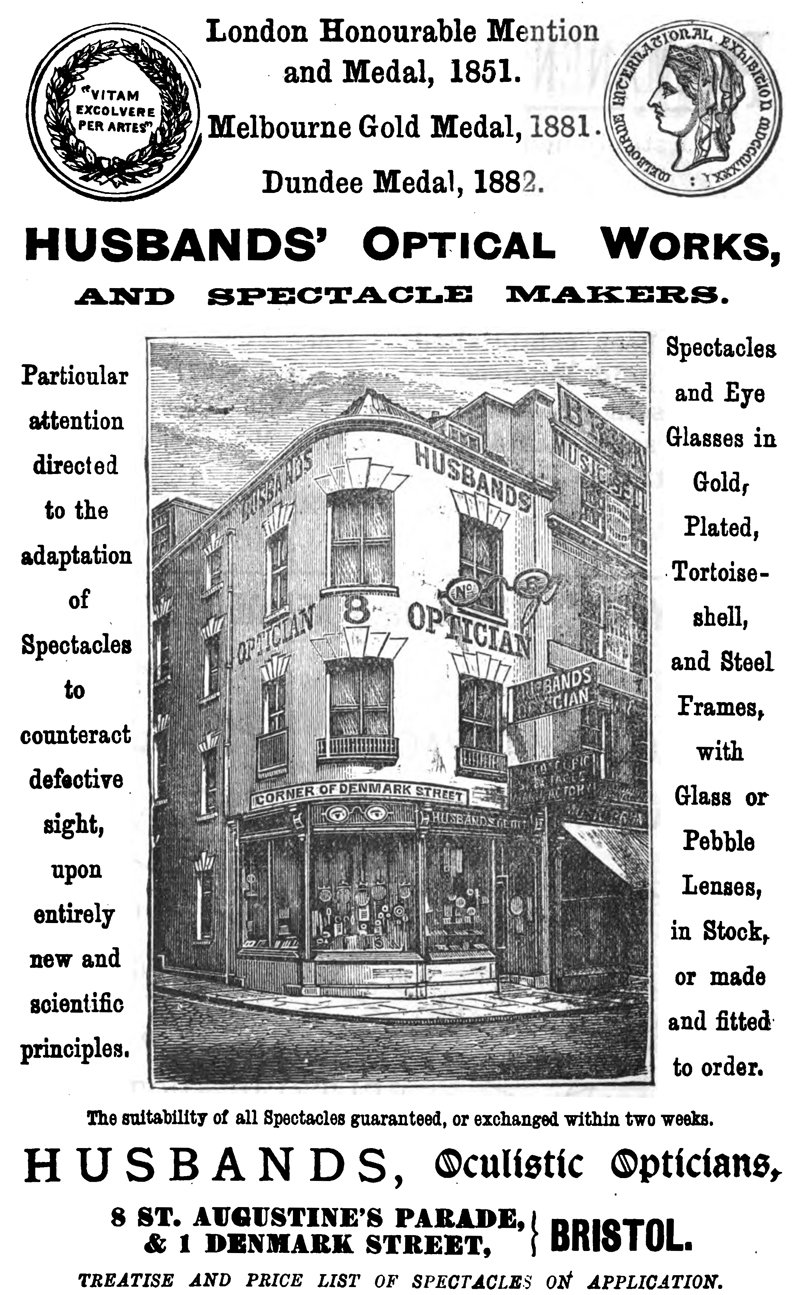
Figure 8. An advertisement for Husbands, showing the
shop on the corner of Denmark and St. Augustine. Husbands took credit for
Thomas D. King’s 1851 Honourable Mention, as his was successor to King’s
business. It is also likely that Husbands contributed to the production of
instruments shown by King in 1851. The Melbourne and Dundee medals were earned
by Husbands outright. Taken from the 1884 ‘Arrowsmith's Dictionary of Bristol’.
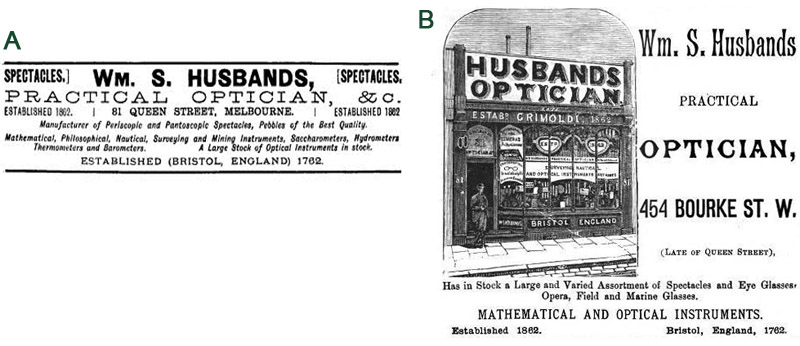
Figure 9. Advertisements for William S. Husbands’
optical shop in Melbourne, Australia, from 1886 (A) and 1889 (B). The
establishment date of 1862 for this branch is the date when Husbands’
predecessor, Grimoldi, opened his business. The establishment date of 1762 for
the Bristol branch is the date when their predecessor Springer opened for
business.

Figure 10. 1883 advertisement.
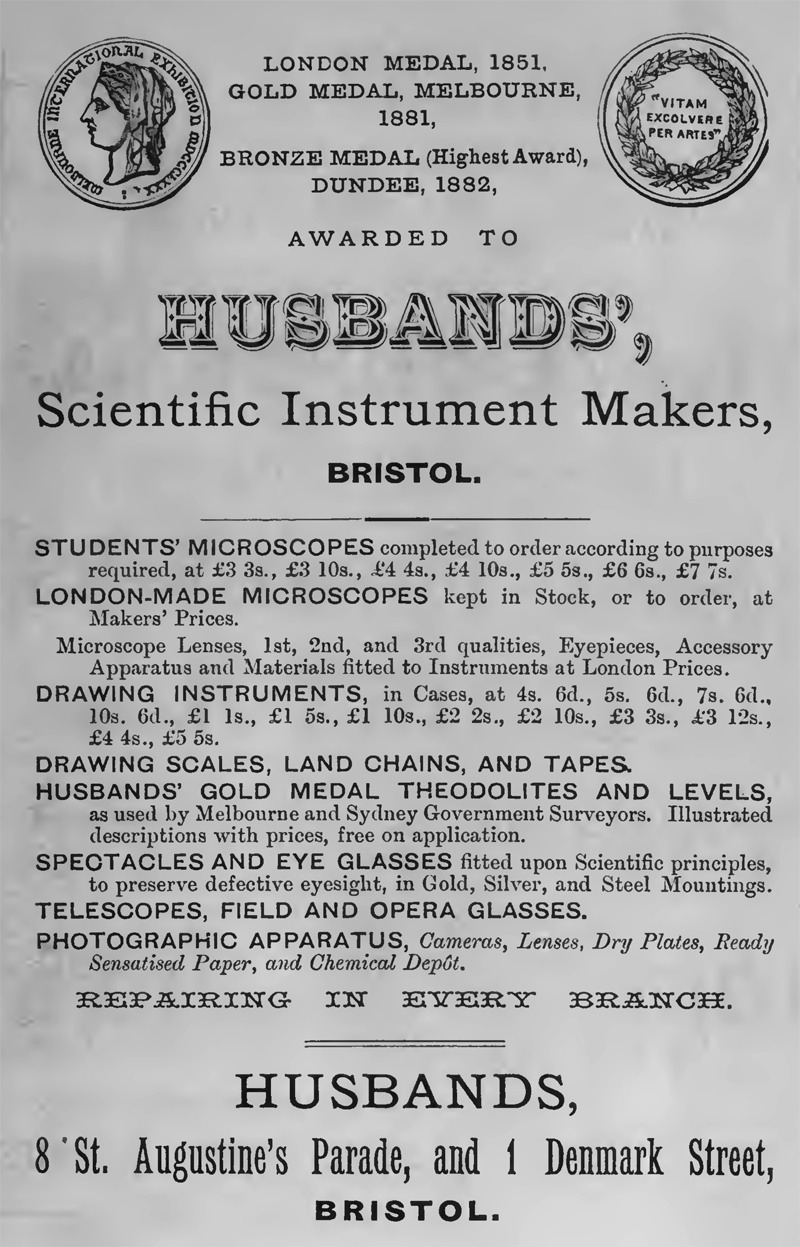
Figure 11. Advertisement from the 1889-1890 University College of Bristol Calendar.
Acknowledgements
Many thanks to Steve Gill for generously sharing information on the history of Husbands and Clarke, and Chris Lord for sharing pictures of a Husbands trade card and telescope.
Resources
Arrowsmith’s Dictionary of
Bristol (1884) Optical works, J.W. Arrowsmith, Bristol, page 149 and
advertisement in front pages
Bath Preservation Society (accessed January 2012) Picture and
information on theodolite made by John King, <>http://www.bath-preservation-trust.org.uk/index.php?id=123
Bracegirdle, Brian (1998) Microscopical
Mounts and Mounters, Quekett Microscopical Club, London, pages 55 and 146,
plate 21
Bristol Medico-Chirurgical
Journal (1883) Advertisement from Husbands, Vol. 1, December issue
British Journal of
Photography (1882) Royal Cornwall Polytechnic Society Jubilee
Meeting, Vol. 29, page 535
The Bristol Mercury (1858)
Advertisements from Husbands and Clarke, beginning April 24 and running weekly
for at least three months
The Bristol Mercury (1863)
Advertisements for magic lanterns, microscopes, etc. from Husbands and Clarke,
December 19
The Bristol Mercury (1867)
The Clifton Industrial Exhibition, April 27
The Bristol Mercury (1870) Dissolution of the partnership between Henry Husbands and William Clarke, October 8
Christening record of William Clark(e) (1810) accessed through
familysearch.org
England census, birth, marriage and death records, and public trees,
accessed through ancestry.co.uk
Exposition Universelle, 1855. Catalogue des Objets Exposes dans la Section Britannique de l’Exposition (1855) "402 KING, T.D., a Bristol, A. - Microscope achromatique; microscope achromatique portatif. Chambre obscure poui’ la photographie", Chapman and Hall, London, page 23
Hallmarks Database and Silver Research, Early Australian Silversmiths
(accessed Jan. 2012) http://www.925-1000.com/forum/viewtopic.php?f=38&t=18484&start=70
King, Thomas D. (1875) Bacon Versus Shakespeare: a Plea for the Defendant, Lovell, Montreal
London Gazette (1853)
Dissolution of the partnership between Thomas D. King and Henry P. Coombs,
February 11
London Gazette (1856) Settlement
of accounts of Thomas D. King, March 11
London Gazette (1910)
Dissolution of the partnership between Henry James Husbands, James Wessen
Husbands and Alfred Witchell Husbands, February 25
Medical Times and Gazette (1860)
Bristol Royal Infirmary, Vol. 2, page 208
Morrison-Low, Alison D. (2007) Making
Scientific Instruments in the Industrial Revolution, Ashgate, Aldershot, Hampshire, pages 52-53 and 60
Museum of the History of Science (accessed January, 2012) Pictures and
information on a microscope by Husbands and Clarke, http://www.mhs.ox.ac.uk/collections/search/displayrecord/?mode=displaymixed&module=ecatalogue&invnumber=43929&query=microscope
Official Catalogue of the
Great Exhibition (1851) entry 287. King, Thomas D., Bristol
Official Catalogue:
Industrial Department (1862) Class 13, Philosophical Instruments,
entries 3003 and 3009, Her Majesty’s Commissioners, London
Pocklington, Henry (1872) The microscope in pharmacy, The Pharmaceutical Journal and Transaction,
Third series, Vol. 2, pages 821-822
The Post Office Directory of Gloucestershire, Herefordshire, Shropshire and the City of Bristol (1863), Husbands and Clarke, Opticians, page 21
Powerhouse Museum Collection (accessed Jan. 2012) Henry Husbands archive, http://www.powerhousemuseum.com/collection/database/?irn=161530
Quarterly Journal of Microscopical Science (1865) British Association, Bath, Vol. 5, pages 74-75
Shakespeariana (1883)
Obituary of Thomas D. King, Vol. 2, pages 35-36
Trevor Philip & Sons Newsletter (accessed January 2012) Pictures and information
on a microscope by Husbands and Clarke, Issue 4, http://www.trevorphilip.com/media/TrevorPhilipTremedia/newsletter/4/news4.htm
University College of
Bristol, Calendar for 1889-1890 (1889) Advertisement from
Husbands, unnumbered page at front
Victoria and its Metropolis, Past and Present, Vol.
II, The Colony and its People in 1888 (1888)
McCarron, Bird and Co, Melbourne, pages 606-607
Webster and Co.’s Directory of Bristol and Glamorganshire (1865) Husbands and Clarke,
opticians, surveying and nautical instruments and spectacle makers, 7 St
Augustine’s parade, and Denmark street, page 134











